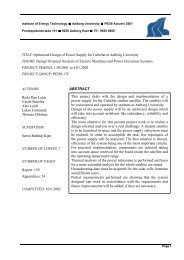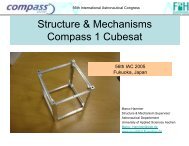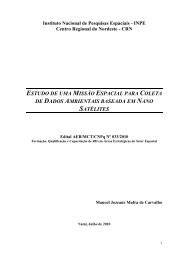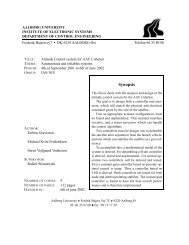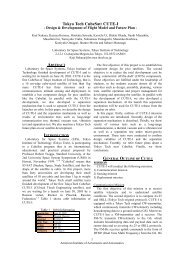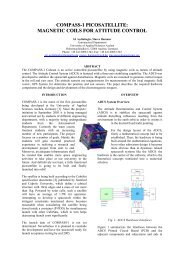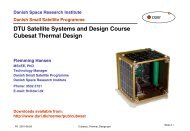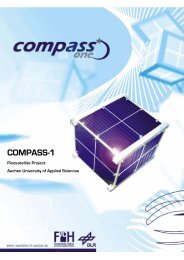Paper.pdf - COMPASS - FH Aachen
Paper.pdf - COMPASS - FH Aachen
Paper.pdf - COMPASS - FH Aachen
- No tags were found...
Create successful ePaper yourself
Turn your PDF publications into a flip-book with our unique Google optimized e-Paper software.
The launch date of Compass-1 is not yetdetermined as a previous launch opportunityhad been canceled. It is planned to concludethe development for launch acceptancetesting by May 2005.2. PAYLOAD AND EXPERIMENTALSYSTEMSAbove all, the satellite will be a platform forexperimental technologies composed ofcomponents that have not been originallydesigned for use in space (i.e. commercialof-the-shelf(COTS) products), as well ascutting-edge space technologies.2.1 Camera ModuleThe OV7648 CMOS camera module hasbeen selected as the imager payload. Itintegrates a fourth generation sensor chipfrom Omnivision and is offered fullyassembled with lens system and electricalinterface. The sensor can capture VGAresolution pictures which will result in earthimages of about 380 km x 450 km at nadirfor the designated orbit.The camera’s exposure time is programmedvia the two-wire I²C bus interface and data isstreamed out over an 8-bit parallel bus. Theimages are in raw data format. Pictures canbe triggered and received by ham usersworldwide that comply with the communicationsarchitecture of the spacecraft.2.2 Attitude Determination and ControlActive attitude control on Compass-1 isachieved by three mutually perpendicularmagnetorquers using a linear quadraticregulator. The targeted nadir-error envelopeis 8° or better. The attitude information isextracted by means of an extended Kalmanfilter from vector observations from a 3-axismagnetometer and five 2-axis MOEMS 1 sunsensors [3]. The sun sensors have beendeveloped by the Denmark Technical1 Micro-Opto-Electro-Mechanical SystemUniversity, Copenhagen, for application on aspacecraft similar to Compass-1. Thesesensors are currently undergoing a testcampaign in order to validate their properfunction under vacuum and thermal cyclingconditions. Also, the electronic sensorinterface is in a re-design stage with the aimto reduce mass, size and power consumption.2.3 Miniature GPS ReceiverThe GPS receiver is originally COTS, butuses advanced software, developedspecifically for LEO satellites by the GermanAerospace Center. The 22g receiver, calledPhoenix [4], has never been flight tested andas such is considered part of the payload ofCompass-1. As long as activated, it providesthe ADCS with (autonomous) orbitinformation, which will be computationallypropagated in between the receiver’soperational phases. The target orbit forCompass-1 is a sun-synchronous orbit at600km altitude with an inclination of about98°.2.4 Command and Data HandlingCore of the Command and Data HandlingSystem (CDHS) is an 8051-based microcontrollerwith powerful features that ease itshandling and respond to the systemrequirements. It is a low power IC with tinyTGFP-64 footprint. A JTAG interface allowsin-system programming and debugging ofthe internal Flash memory which stores theflight software. A FIFO is used to buffer thedata from the payload which is streamed outat a very high frequency. Later on the buffercontent is transferred to the external Flashdevice for non-volatile data storage. None ofthose ICs has yet been tested in space. Inparticular the characteristic of the Flashmemory, when exposed to LEO environment,is of interest for future missions.3. APPROACHESFacing the design and development of anentire satellite is always a challenging



